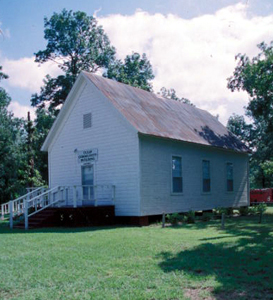Listed in Arkansas Register of Historic Places on 09/06/00
SUMMARY
Constructed in 1902, the one-room Tulip Schoolhouse is being nominated to the Arkansas Register of Historic Places with local significance under Criterion A as the last remaining building, associated with the early development, implementation, and promotion of education in Tulip, Arkansas. The Tulip Schoolhouse represents the continuance of Tulip’s historic legacy as an educational center.
ELABORATION
Tulip, in Dallas County, was known originally as Tulip Ridge or Tulip Village. Some sources state that the town’s name was derived from a French hunter “Tulipe,” who had been in the area prior to 1804 and other sources say the town was named for its beautiful Tulip trees. By 1842 the small settlement of Tulip boasted four families and a few hunters; and on 1 January 1845 Dallas County was formed from Clark County with Princeton as the county seat.
By the mid to late 1800s Dallas County was known for its educational interest, and Tulip was one of the towns whose schools were reputed to be of a high caliber and were renown around the state. During the period before the Civil War, Tulip was known as the “Athens of Arkansas.” In 1849, John D. Garvin, an educator who graduated from Washington College in Virginia (later Washington and Lee), opened a school called the Alexander Institute for both males and females.
On 17 December 1850 a charter was granted to establish the Arkansas Military Institute and the Tulip Female Collegiate Seminary. Major Benjamin J. Borden was appointed superintendent of the Female Collegiate Seminary and the school opened with seven teachers. At the seminary, women studied needlework, drawing, painting, writing, and general liberal arts. They also could study the piano, harp, or the guitar. In 1858, the school was taken over by the Methodist Church and on 22 December 1860 it was incorporated and became known as the Ouachita Conference Female College. However, the school closed shortly after its incorporation in 1861 due to the Civil War.
George D. Alexander, founder of both schools, was appointed superintendent of the Military Institute, which was attended by young men from all over the state, many of whom graduated with honors. Among its alumni is James Kimbourough Jones, who later became one of the great United States senators. While at the institute, young men studied ancient languages, surveying, engineering, math, military tactics, chemistry, and natural philosophy. At the opening of the Civil War the Military Institute closed and many of the young men left to fight in the Civil War under the tutelage of their superintendent and teacher George D. Alexander.
Both the Arkansas Military Institute and the Tulip Female Collegiate Seminary were destroyed in April of 1864 when federal troops, being pursued by Confederates, came through Tulip burning many buildings including the two schools. In an effort to rebuild after the Civil War, public schools were instituted in Dallas County by 1874, and by 1888, in Dallas County there were 40 districts.
In 1902 the Tulip Schoolhouse was constructed to meet the educational needs of children and youth in Tulip. For forty-three years (1902-1945) the Tulip Schoolhouse served as an educational facility. In 1938, the Tulip Schoolhouse consolidated with Carthage Schools. However, the Tulip Schoolhouse was still used to house students in grades first through fourth. Seven years later, in 1945, the school closed its doors to all students. Tulip, like many towns never recovered from the Civil War, nor did it survive being surpassed by the railroad. Today, Tulip is a very small community and the Tulip Schoolhouse is the only remaining historic structure associated with the early educational success of Tulip. Furthermore, it is the only extant building in Tulip that has served as an educational facility. From 1945 until the late 1990s the Carthage School District owned the Tulip Schoolhouse. In 1998 the Tulip Schoolhouse was deeded to the Tulip Fire department who presently owns the building. The building currently functions as a community center.
SIGNIFICANCE
Since its heyday as an educational center during the mid 1800s, Tulip has become a sleepy southern Arkansas town that has nothing to remind it of its past as the “Athens of Arkansas.” All that remains today, which is representative of Tulip’s success as an educational enclave, is the Tulip Schoolhouse. Although, it was not established until after Tulip had reached the apex of its educational notoriety, the teachers at the Tulip Schoolhouse strove to uphold the legacy of education and this building is the only remaining educational facility in Tulip. Due to various alterations on the exterior of the building the structure is being nominated with local significance, to the Arkansas Register of Historic Places under Criterion A as the last remaining building, associated with the early development, implementation, and promotion of education in Tulip, Arkansas.
BIBLIOGRAPHY
Deane, Ernie. “Athens of Arkansas,” The Arkansas Traveler, date unknown.
Jacobs, Duane, “title unknown,” Fordyce News Advocate, date unknown.
Rogers, Joy. Interview by Kara Mills, 24 July 2000.
Smith, Hershal Kennon, Jr. “Ante-Bellum Schools at Tulip, Arkansas” in the Arkansas
Historical Quarterly Vol. XVIII, No. 3 (Autumn 1959): 280-286.


